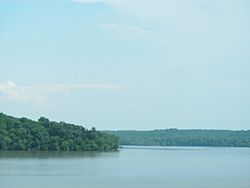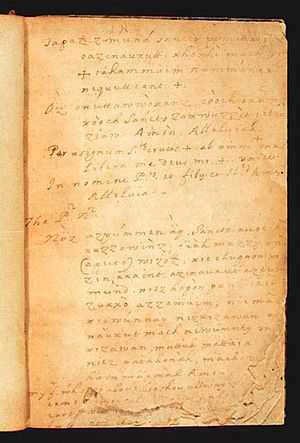Kittamaqundi facts for kids
Quick facts for kids
Kittamaqundi
|
|
|---|---|

|
|
| Country | |
| State | |
| County | |
| Population
(2013)
|
|
| • Estimate
()
|
Disbanded |
| Time zone | UTC-5 (EST) |
| • Summer (DST) | UTC-4 (EDT) |
Kittamaqundi was a historic village of the Piscataway tribe. It was built around 1622 on Piscataway Creek. This area is now part of Prince George's County, Maryland. The village was named after its leader, Tayac Kittamaquund. He became the leader in 1633. English visitors first came to Kittamaqundi in 1634.
Contents
Understanding the Name Kittamaqundi
The name Kittamaquund was translated in different ways by the English. Some called it Chitomachen. One meaning for Kittamaqundi is "Great Beaver Place." Another meaning for Chitomachen is "strong bear."
History of the Piscataway Village
Before Kittamaqundi, the main Piscataway town was Moyaone. It was located on Accokeek Creek near the Potomac River. Moyaone was left empty after a fire. Other reasons for leaving Moyaone might have been hunger, sickness, or attacks. These attacks could have come from English settlers or other Native American tribes.
Dealing with New Settlers and Tribes
Kittamaquund chose to try and get along with the English. Across the Potomac River, Wahunsenacawh was a powerful leader. He had died in 1618. In his last years, he told his tribes not to trade food with the English. He wanted the English to leave.
The Piscataway tribe spoke a similar language. However, they were not under Powhatan's control. They were willing to trade food with the English. They hoped the English would help them against Susquehannock and Seneca raiders. These raiders were attacking their villages.
On March 22, 1622, a new war leader, Opchanacanough, led attacks on English settlements. These attacks almost destroyed the Jamestown, Virginia settlement. This event started the second Anglo-Powhatan war.
Jesuit Mission in Kittamaqundi
In June 1639, Jesuit missionaries arrived in Kittamaqundi. They were led by Father Andrew White. White wrote about helping Kittamaquund and his son get better from an illness. He used a special powder, holy water, and a method called bloodletting.
On July 5, 1640, Father White baptized the chief. He was given the Christian name "Charles." His wife was named "Mary." Their counselor, Mosorcoques, was named "John." Father White then married Charles and Mary.
The couple sent their seven-year-old daughter, also named Mary, to live with Governor Leonard Calvert. She lived with his sister-in-law Margaret Brent in St. Mary's City, Maryland. There, she learned English customs. By 1642, six Jesuits lived in the village.
The Jesuits left the village in 1643. This happened after Susquehannock raiders took their men and supplies. In 1644, English settlers took over the town. They used it as a protective outpost during another war.
Changes in the Village
By 1675, the Susquehannock people had moved into Kittamaqundi. English settlers had forced them from their own lands. The Susquehannock used Kittamaqundi's farming fields. They built a long wall around the village for protection.
Virginia and Maryland soldiers, led by Major Truman, blamed the Susquehannock for conflicts with settlers. During peace talks, a tragic event occurred where five Susquehannock leaders were killed. This led to more conflicts and helped start Bacon's Rebellion.
Later Years of the Piscataway People
The Piscataway signed a treaty with William Penn in 1701. Many Piscataway people moved. By 1718, some had settled near Conoy Creek in Pennsylvania. In 1704, English settlers founded the town of Piscataway, Maryland. This new town was built near or on the old site of Kittamaqundi. A church in nearby Port Tobacco, Maryland has a stained glass window. It shows Kittamaquund's baptism.
Daily Life in the Village
Villagers lived in oval-shaped homes. These homes were made from saplings covered with animal hides. They had a hole in the center for light and smoke from a fire. Tribe leaders had beds raised off the ground.
To clear land for farming, people would remove bark from trees. This would kill the trees. Then, they used fire to clear the field. Once cleared, they made mounds of dirt. Corn was planted in these mounds. Bean plants grew up the corn stalks for support. Squash was grown between the mounds.
The village was by the river. People caught fish and collected oysters using canoes. Kittamaquund, as the leader, wore shells. These shells showed his important role.


